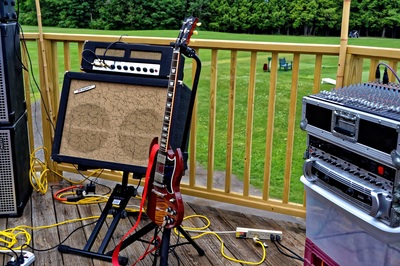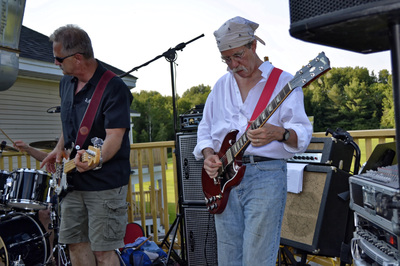The photographs below feature no one notable - just me, playing my faithful Gibson SG with my band "Misspent Youth" at a gig in Cumberland, Maine this summer:
I generally use the Model R2523D Champion shown in these photographs. It's a two-channel model of the Champion that allows me to bridge the "Bright" input on Channel 1 to the "Inst" input on Channel 2 and then plug into the "Accordion" input on Channel 2. As I have mentioned elsewhere on this site, each of the inputs is distinctively voiced, and the "Accordion" input on this and most Hilgen amplifiers delivers, in my opinion, the widest tonal range and most prominent overtones of the four inputs. (I have also used a single-channel Champion and a Model B2503 Basso Grande with highly satisfactory results.) These relatively low-wattage amps start clipping pretty quickly when cranked, so that without effects pedals and at tolerable volume levels, they produce a smooth, warm, dark overdrive. They respond unusually to pedals; whatever effects are being used seem to "bloom" from the amp after some compression rather than being glaring or processed-sounding. At one gig, where the conditions were just right, I used no distortion/overdrive pedals at all for lead solos and relied entirely on a clean boost pedal to push the amp into a wonderfully sustaining overdrive sound. At times the sound can resemble that of Neil Young's Fender Deluxe amps in his live recordings with Crazy Horse. If so desired, they feedback readily and musically.
I have on several occasions communicated with persons who complained that their Hilgens, "though fine for studio work, they just don't 'cut through' when I play live with my band." I am skeptical of such complaints. Unless your band requires super-clean tone at ear-splitting volumes, the Basso Grande, Champion, and SwingAway models are powerful enough to keep up with any modern 50 watt amp and sound great while doing so. (Indeed, I have frequently drawn objections from my bandmates when I have underestimated my volume levels.)
This is not to say that the lower-wattage Hilgens would not also work well in a band setting; I simply have not tried using them for that purpose.



 RSS Feed
RSS Feed